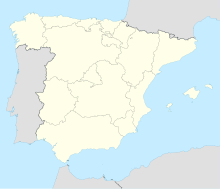Museum of Almería
| Museo Arqueológico de Almería | |
 |
|
| Established | 1934; in present location since 2006 |
|---|---|
| Location | 91, Carretera de Ronda, 04005 Almería, Andalusia, Spain |
| Coordinates | 36°50′18″N 2°27′20″W / 36.838333°N 2.455417°W |
| Type | Archaeological Museum |
| Visitors | 55.617 (2012) |
| Director | María Isabel Pérez Bernárdez |
| Website | [1] |
The Museum of Almería is one of the most important museums in the Almerian province and maintains the largest collection of archaeological remains in Almería. The Museum is situated in Almería (Andalusia, Spain), Carretera de Ronda Street, 91. In 2006 the museum moved to a new building designed by Ignacio García Pedrosa y Ángela García de Paredes. The building won two awards (PAD and ARCO) in 2004. This building was also finalist in 2005 in the Fostering Arts and Design (FAD) Awards and it in 2008 an honorable mention by the European Museum of the Year contest which took place in the European Museum Forum. The museum has been a public institution since 1934, marking its 80th anniversary in 2014.
The first attempt at the creation of the Museum of Almería dates back to the 19th century. In 1880 the Belgian engineer Luis Siret found the most famous prehistoric site in this region. Due to his archaeological researches, he developed a significant collection of ancient pieces which he finally donated to the National Archeological Museum, with the desire that one part of the collection stays in Almería. The conditions were agreed during the Second Spanish Republic when the archeological museum was opened. There were two small rooms which were handed over by the “Escuela de Artes y Oficios” in 1934 but this collection didn’t have the pieces that Louis Siret had hoped would remain in Almería. After a lot of difficulties which took place throughout the years, 2006 was the year that the museum finally settled into its new place.
The new museum has three floors in which the museum collections are distributed. The backbone running up though all the floors is a huge stratigraphic column that goes up almost to the roof of the building. The exhibition is mainly dedicated to recent Copper and Bronze Neolithic Age history.
Hall, with "Siret Cloud". Museum of Almería.
Model on archaeological methodology.
Stratigraphic column.
Assembly hall of the Museum of Almería.
Outside of the "Circle of Life" (Prehistoric Society Los Millares).
Inside of the "Circle of Life" (Prehistoric Society Los Millares).
"Circle of Death" (Prehistoric Society Los Millares).
...
Wikipedia

